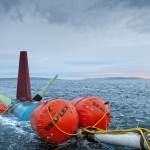Nautricity
Nautricity was formed in 2010 from the University of Strathclyde’s Energy Systems Research Unit in the Department of Mechanical Engineering.
Nautricity’s CoRMaT tidal energy converter is a contra-rotating turbine, suitable for deployment in water depths of 8 to 500m. CoRMaT uses two closely spaced dissimilar rotors, moving in opposite directions directly driving the rotor and rotating stator sections of an electrical generator. Station keeping is undertaken via a tensioned mooring system.
The device has progressed through systematic technology readiness level development steps, and has successfully generated electricity in a marine tidal setting.
First EMEC test period | 2014
The full scale system underwent testing at EMEC’s Shapinsay Sound test site during 2014.
Robbie Macdonald, Project Engineer at Nautricity, reveals the benefits that were gained during testing the CoRMaT tidal energy converter at Shapinsay Sound in the following case study:
Second EMEC test period | 2017-2018
In 2015, Nautricity signed up to a grid-connected tidal test berth at EMEC’s Fall of Warness tidal test site. The 500kW CoRMaT turbine was installed in April 2017 and recovered in March 2018 to analyse the turbine, supporting systems and data to assess the impact of extended exposure. The testing period at EMEC has been supported by the Interreg NWE FORESEA project, which enables free access to EMEC’s test facilities.

Related news:
- April 2017: Nautricity deploys tidal turbine
- March 2017: EMEC tidal site activity ramping up
- November 2016: FORESEA awards support to ten ocean energy technology developers
- July 2015: Marine energy developers share knowledge at Component Analysis Workshop
- February 2015: Nautricity secures grid-connected test berth at EMEC
- September 2014: Benefits of real sea testing – Nautricity’s experience
- May 2014: Congratulations to Nautricity on tidal turbine deployment










